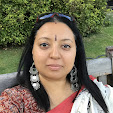Holi is the festival of colors. It heralds the arrival of spring and commemorates the victory of good over evil. There are a lot of mythological stories about why it is celebrated.
It is more of a North Indian celebration and hence I was introduced to it a few years ago when I headed North to study. Although it is now celebrated all over the country.
Holi was historically the festival of the masses and on a social level it allowed the various classes to mix more freely than normal social customs allowed.
It is most commonly celebrated by throwing or applying colors (gulal) on each other. Either in the form of powdered colors or color mixed into water and sprayed using a contraption called a "pichkaari" or just buckets of colored water being dumped on unsuspecting people.
Historically the colors were made from natural flower petals, fruits of certain trees, leaves, bark etc. A lot of the colors were made from trees/plants with ayurvedic properties that helped strengthen immunity against diseases caused by the change in seasons.
In the past few decades, commercially made colors have proliferated which take a few days to get the stains out of skin, hair, clothes, floors and have harmful chemicals that are bad for the skin and the flora and fauna when they get into the eco system.
In the last few years, there has been a small but growing movement to move back to Natural colors. But they are currently much more expensive to buy and nobody has the time to make them at home anymore.
There are other versions of holi where it is played with flowers and petals and there is one version celebrated in a small town in India where the women have an opportunity to beat up the men with sticks and the men have just a small shield to protect themselves.
Subscribe to:
Post Comments (Atom)














No comments:
Post a Comment